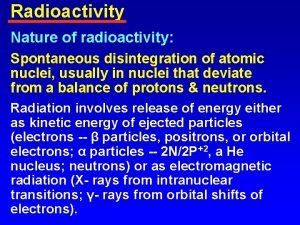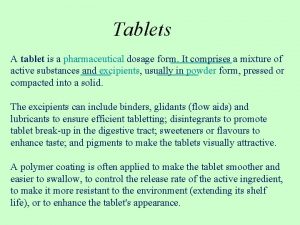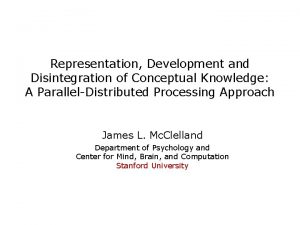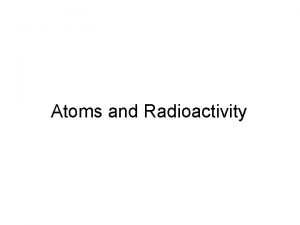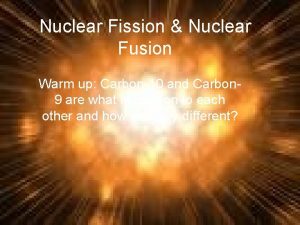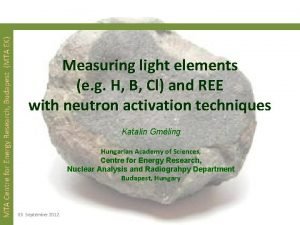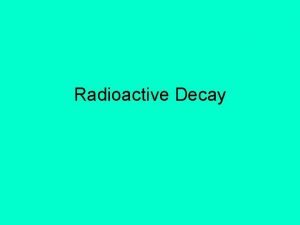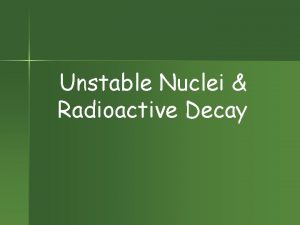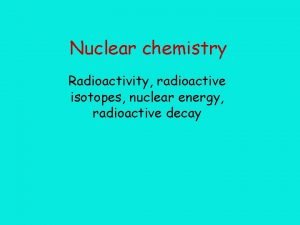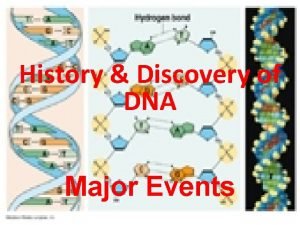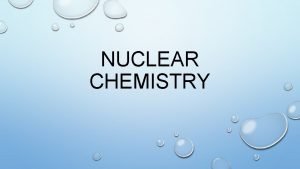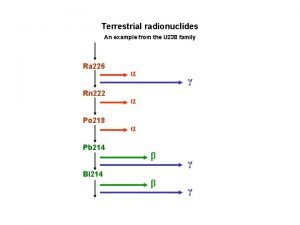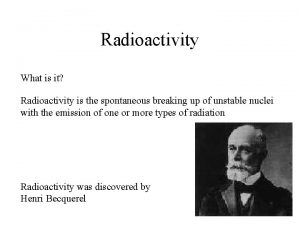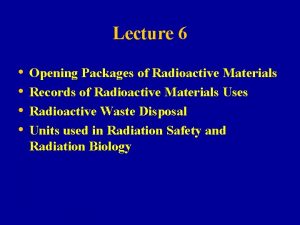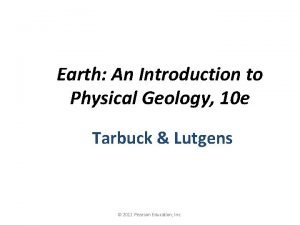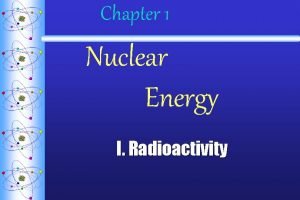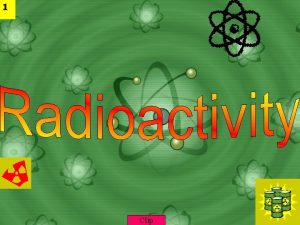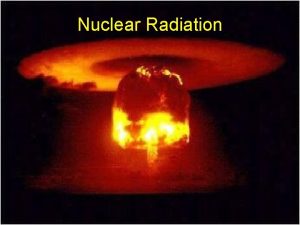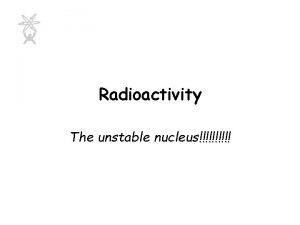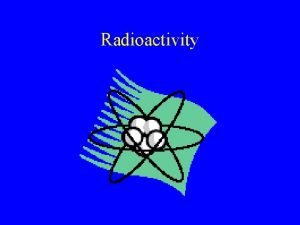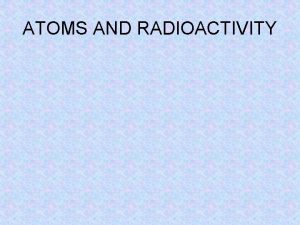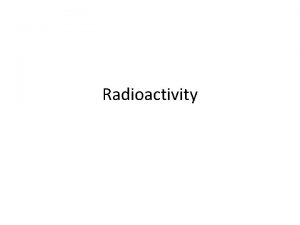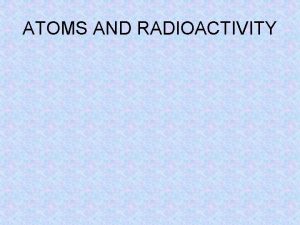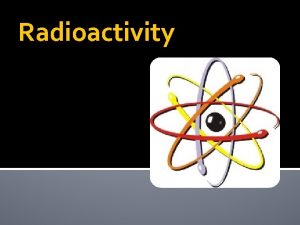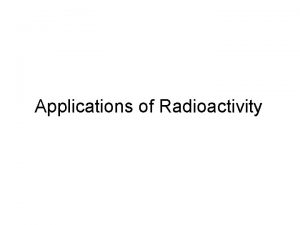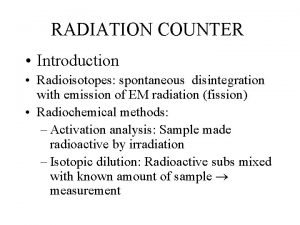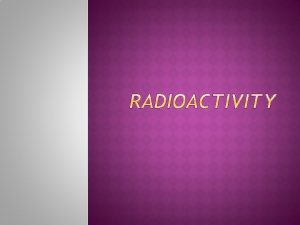1 Clip 3 Radioactivity is the spontaneous disintegration
























- Slides: 24

1 Clip

3 Radioactivity is the spontaneous disintegration of atomic nuclei. The nucleus emits α particles, ß particles, or electromagnetic rays during this process. After decaying, radioactive atoms “change” into other atoms Clip

4 • Why does the atom do this? – the nucleus of an atom attempts to become more stable • In some instances, a new element is formed and in other cases, a new form of the original element, called an isotope, appears. – this process of change is often referred to as the decay of atoms. • The rate of Radioactive decay is described in halflives

5 Energy is released during radioactive decay

6 Types of Nuclear Radiation • When an unstable nucleus decays, particles and energy are given off from the decaying nucleus. • α and β radiation is in the form of particles • γ radiation is in the form of waves-kind of like light but higher frequency

7 Nuclear Decay 2 protons & 2 neutrons Neutron decays into a proton

• Alpha particles consist of two protons and two 8 neutrons, neutrons identical to the nucleus of a helium atom. • A sheet of paper or a person’s surface layer of skin will stop them. • Alpha particles are only considered hazardous to a person’s health if they are ingested or inhaled and thus come into contact with sensitive cells such as in the lungs, liver and bones.

9

10 • Beta particles are electrons emitted from the nuclei of many fission products. • Unstable Neutron decays into a proton. • They can travel a few feet in air but can usually be stopped by clothing or a few centimeters of wood. • They are considered hazardous mainly if ingested or inhaled, but can cause radiation damage to the skin if the exposure is large enough.

11

• Gamma rays are a form of electromagnetic radiation (like light, radio, and television) that come from the nucleus of a radioactive atom. – Occurs when an unstable nucleus emits electromagnetic radiation. The radiation has no mass, and so its emission does not change the element. – They penetrate matter easily and are best stopped by water or thick layers of lead or concrete. – Gamma radiation is hazardous to people inside and outside of the body. • However, gamma radiation often accompanies alpha and beta emission, which do change the element's identity. • Gamma rays have the lowest ionizing power, but the highest penetrating power. 12

13

18 Fission and Fusion Fission Fusion Splitting a nucleus Combining of two nuclei.

19 • Nuclear power can come from the fission of uranium, plutonium or thorium or the fusion of hydrogen into helium. • Today it is almost all uranium. • The fission of an atom of uranium produces 10 million times the energy produced by the combustion of an atom of carbon from coal.

21 FUSION • A fusion reaction occurs when nuclei of light elements, specifically hydrogen and its isotopes (deuterium, or "heavy water, " and tritium), are forced together at extremely high temperatures and densities until they fuse into nuclei of heavier elements and release enormous amounts of energy. • If fusion is to yield net energy, the fuel must be heated in the form of plasma (a highly ionized gas) to a very high temperature and the plasma must then be held together for a sufficiently long time such that the number of fusion reactions occurring releases more energy than was required to heat the fuel.

Nuclear Isotope Notations

Nuclear Isotope Notations • Nuclear Isotope notation is used so we can keep track of the type of decay of an atom • Alpha and beta particles can be included in chemical equations to show nuclear radiation

22 Half Life is the amount of time it takes for half of the nuclei in a sample to decay Mass (kg)


12 C mass number 14 C 13 C • Carbon occurs naturally in three isotopes. • All of these atoms have the same number of protons but different numbers of neutrons. • The number of neutrons and protons determines the mass, so the masses are different. • 14 C is radioactive.

14 C • Radioactive 14 C acts chemically just like 12 C, so it becomes incorporated into plants an animals. • When the animal/plant dies the 14 C begins to decay into 14 N at a know rate, so we can determine how long ago the organism died. • This is called Carbon Dating. • It’s only good for about 50, 000 years.

26 • The half life of 14 C is 5, 730 years. • If a sample originally contained 100 g, how much would be left after 11, 460 years? 50 g 25 g


Older Dating Methods • The isotopes 235 U and 238 U can be used to date objects billions of years old. • 235 U has a half life of 704 million years. • 238 U has a half life of 4. 5 billion years. • Mainly used for rocks.
 Radioactivity as spontaneous disintegration
Radioactivity as spontaneous disintegration Disintegration definition
Disintegration definition Theory of positive disintegration
Theory of positive disintegration Tablet in tablet dosage form
Tablet in tablet dosage form Dissolution vs disintegration
Dissolution vs disintegration Content uniformity definition
Content uniformity definition Knowledge through disintegration
Knowledge through disintegration Theory of positive disintegration
Theory of positive disintegration Defination of radioactivity
Defination of radioactivity Radioactivity phenomenon
Radioactivity phenomenon Are nuclear power plants fission or fusion
Are nuclear power plants fission or fusion Radioactivity
Radioactivity Defination of radioactivity
Defination of radioactivity Natural radioactivity
Natural radioactivity Nuclear transmutation equation
Nuclear transmutation equation Key terms radioactivity and nuclear reactions
Key terms radioactivity and nuclear reactions Natural and artificial radioactivity
Natural and artificial radioactivity Radioactivity
Radioactivity Defination of radioactivity
Defination of radioactivity Environmental radioactivity
Environmental radioactivity Who discovered radioactivity
Who discovered radioactivity Units of radioactivity
Units of radioactivity Radioactive decay law
Radioactive decay law Unconformity
Unconformity Defination of radioactivity
Defination of radioactivity
